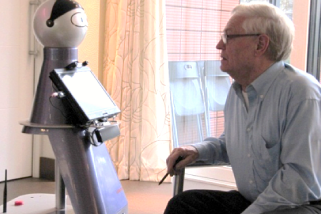Could robots one day play an important role in enabling the world’s ageing population to live safely and independently in their own homes?
“Yes” was the definitive answer delivered at a ground breaking occasion on 9 September 2015 when leading medical and technical experts from around the UK, together with Anchor Society supporters, gathered to witness the official opening of the new Anchor Robotics Assisted Living Facility – housed at the Bristol Robotics Laboratory (BRL) of University of the West of England.
Almost 100 guests in attendance to celebrate the opening received a privileged insight into how the pioneering work of the BRL is now showcased and tested in the new Assisted Living Facility – a furnished apartment kitted out with a series of sensors and aids.
Anchor Society has sponsored the creation of the assisted living facility to speed the development of life-improving – and potentially life-saving – technologies, and also to ensure that these technologies will be accepted and used by the people they are intended to help.
The BRL, which is a joint venture between University of the West of England and University of Bristol, is the largest academic facility of its kind in the UK. It is home to over 150 scientists, engineers and psychologists, all of whom are collaborating on developing new ways to harness robotics and intelligent autonomous systems to improve our quality of life – with many of them dedicated to solving the problems faced by elderly, isolated and disabled people.
Anchor Society President Canon Dr John Savage said “by sponsoring the new facility we will ensure that the needs and aspirations of older people are met – by getting older people themselves to test out and help refine the new technologies in an environment they recognise and understand.”
Adds Bob Durie (Anchor Administrator): “Inventing ground breaking devices that could change the world is one thing, but making sure that older people will welcome them into their homes and their lives is quite another. This is why we wanted to support the excellent work going on here.”
In his introduction to the event, Steve West, UWE Vice Chancellor, put the work of the BRL into the context of societies around the world struggling to deal with the growing cost of providing care and enabling people to remain independent in their own homes. The development work at BRL, he added, would go on to provide business opportunities as well as improve lives. A new enterprise zone is being established next to the BRL to enable spin out and other associated businesses to tap into and commercially exploit the technologies being created.
He also highlighted the fact that the work by the young people at the laboratory, part of the army of 50,000 students attending UWE and the University of Bristol, was a powerful way of bringing generations together.
Dr Praminda Caleb-Solly (Associate Professor Independent Living Systems) then showed films of how new ideas and innovations would be tested – with older people a key element in their development – before leading guests on a tour of the new Anchor Robotics Assisted Living Facility, where Anchor President Canon Dr John Savage was given the task of cutting the ceremonial ribbon.
Guests then met an array of robot helpers in various stages of development, including Molly – who has already found fame on a number of TV stations. Dr Praminda Caleb-Solly also demonstrated how someone could be guided to cook a meal safely in the Anchor facility’s kitchen – potentially one of the most hazardous tasks faced by someone with restricted mobility or cognitive decline.
Treats sampled by some visitors included being wired up and fitted with special glasses, which allowed them to act as the eyes and ears of a robot and then control its movements. Another was to try out a new device to help someone with limited leg strength to get into and out of a sitting position and move around their apartment safely.
So what will all these innovations mean to the lives of older people once they reach the market?
Claire Miller, Chief Executive of the charity LinkAge, emphasised how new technologies must complement rather than replace personal care, delivered by real people – many of whom have lives blighted by loneliness and isolation. And this point was taken up by the keynote speaker Professor Cameron Swift, Emeritus Professor of Health Care of the Elderly at King’s College School of Medicine in London, who demonstrated the statistical links between poor health and isolation.
Professor Swift drew particular attention to some of the many “myths” that were perpetuated about the negative aspects of an ageing society – not least the one that older people were an increasing burden. People are now getting “older” later in life, but are continuing to contribute to society in the workplace and in voluntary roles for many more years than ever before.
Also he punctured the myth that poor health and an increasingly restricted life are inevitable in our later years. What was required to buck this trend, he maintained, was closer working between the health and social care professionals to improve the quality of life of those encountering health or mobility issues – including those wanting to return home from hospital after a fall.
The new technologies being developed by the researchers at BRL and proven in the Anchor Assisted Living Facility, he said, could play a key role in delivering a better future for tomorrow’s older generation.

